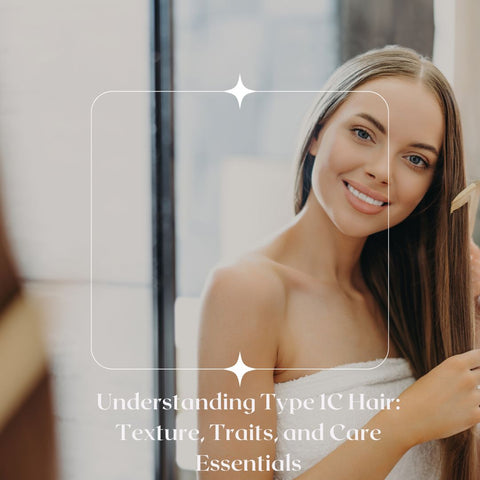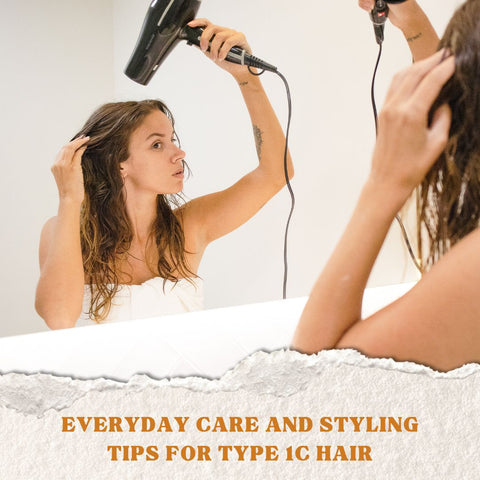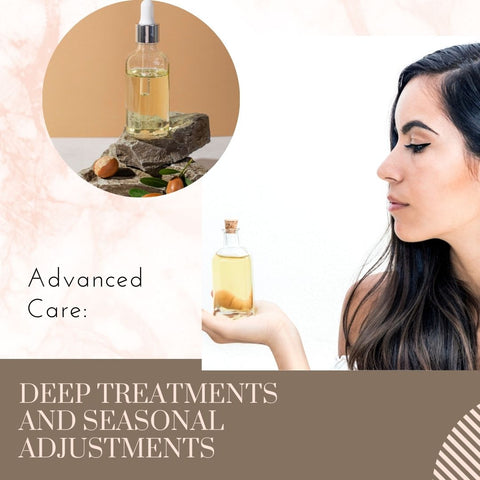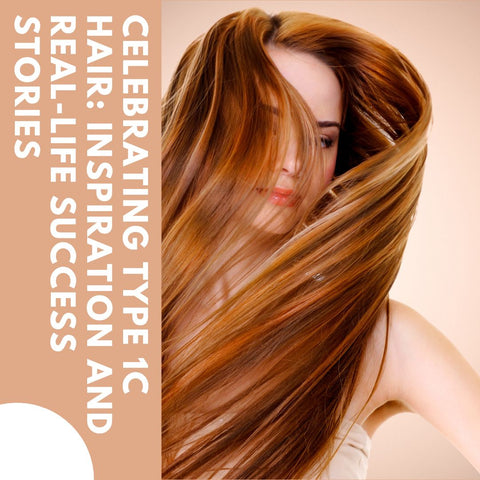Understanding Type 1C hair's unique characteristics and following a comprehensive care, styling, and maintenance routine tailored to its needs are essential for mastering it. This is a comprehensive guide to caring for, styling, and maintaining your Type 1C locks.
Understanding Type 1C Hair: Texture, Traits, and Care Essentials

Understanding Type 1C hair entails recognising its texture, characteristics, and the essential care routines required to keep it healthy and beautiful.
Texture:
Type 1C hair is distinguished by its straight pattern with a slight wave or bend. It has a fine texture, which means that the individual strands are very thin in diameter. Despite the presence of waves, Type 1C hair is typically low in volume and can appear flat.
Traits:
-
Type 1C hair appears straight overall, but there may be a subtle wave or bend throughout the strands.
-
Individual strands of Type 1C hair are fine and delicate, making them susceptible to breakage and damage.
-
Type 1C hair frequently lacks volume and appears flat, particularly near the roots.
-
The scalp's natural oils travel down the straight strands of Type 1C hair fairly easily, resulting in greasiness at the roots and dryness at the ends.
Care Essentials:
-
Cleanse Type 1C hair with a mild, sulfate-free shampoo to avoid stripping away its natural oils. Focus the shampoo on the scalp to remove buildup and excess oil, and avoid overwashing, which can cause dryness.
-
To moisturise and detangle Type 1C hair, apply a lightweight, hydrating conditioner. Apply the conditioner from mid-length to ends, avoiding the roots to keep the hair from becoming heavy.
-
Excessive heat can damage Type 1C hair, so use heat styling tools like flat irons and curling wands sparingly. If you must use heat, apply a heat protectant spray first and use the lowest heat setting possible.
-
Trim your Type 1C hair every 6-8 weeks to avoid split ends and keep it in good condition. Trimming also removes damaged or broken ends, which promotes healthy growth.
-
Use protective hairstyles like loose braids or buns to reduce friction and the risk of breakage, especially when sleeping or engaging in activities that can damage the hair.
-
Maintain a healthy scalp by gently massaging it while shampooing to increase circulation and hair growth. Consider using a scalp scrub or treatment once in a while to remove buildup and revitalise the scalp.
-
Keep Type 1C hair hydrated by adding deep conditioning treatments or hair masks to your weekly or biweekly routine. Look for products that include moisturising ingredients such as shea butter, coconut oil, or hyaluronic acid.
What Makes Type 1C Hair Unique: Identifying Characteristics
Type 1C hair is unique due to its blend of characteristics that fall between straight and wavy hair types. Here are some identifying characteristics of Type 1C hair:
-
Type 1C hair typically has a subtle wave pattern, with waves that may be loose or tighter depending on the individual.
-
It tends to have more volume and body compared to straight hair types, thanks to its slight wave pattern.
-
Frizz can occur in Type 1C hair, particularly in humid or dry conditions. Its texture makes it frizz-prone, though to a lesser extent than curlier hair types.
-
Type 1C hair often has natural shine due to the way light reflects off its smooth surface. Proper care can improve the shine and give the hair a healthier appearance.
-
It is typically between the manageability of straight and wavy hair types. While it may require some styling to bring out its natural wave pattern, it is often easier to manage than curlier hair types.
The Advantages and Challenges of Managing 1C Hair
Managing Type 1C hair presents its own set of benefits and challenges. Here's the breakdown::
Advantages:
-
Type 1C hair is versatile when it comes to styling. Its slight wave pattern allows for a variety of styling options, including wearing it straight or enhancing the waves for a beachy look.
-
Compared to straight hair types, Type 1C hair has more volume and body, giving it a fuller appearance without requiring extensive styling.
-
Type 1C hair often has natural shine due to its smooth texture. With proper care, it can keep its glossy, healthy appearance.
-
While it has some wave, Type 1C hair is typically easier to style than curlier hair types. It often requires less time and effort to achieve desired looks.
-
The subtle wave pattern of Type 1C hair adds dimension and interest to hairstyles without the need for heat styling or chemical treatments.
Challenges:
-
Frizz can occur in Type 1C hair, particularly in humid or dry conditions. Frizz can be managed with proper hydration and the use of anti-frizz products.
-
Type 1C hair may lack volume and bounce compared to curlier hair types. To combat flatness, people with Type 1C hair may need to use volumizing products and styling techniques.
-
Type 1C hair's wave pattern may not always be clearly defined, resulting in a less uniform texture. To enhance the waves, you may need to use styling products and techniques.
-
Type 1C hair can sometimes be weighed down by its own natural oils or heavy styling products, leading to a limp appearance. Using lightweight products and avoiding product buildup can aid in maintaining volume and movement.
-
Type 1C hair, like many other hair types, can become frizzy or limp as humidity levels change. Anti-humidity products can help to reduce the effects of humidity on hair.
Selecting the Right Hair Care Products for 1C Texture
Selecting the right hair care products for Type 1C hair is essential to maintaining its natural beauty and manageability. Here's a guide to help you choose the best products for your Type 1C texture:
-
Shampoo: Look for light, volumizing shampoos designed for straight or slightly wavy hair. Avoid sulfate-containing products, as they can strip the hair of its natural oils and cause dryness. Choose sulfate-free formulas that gently cleanse the hair without weighing it down.
-
Conditioner: Use a lightweight conditioner that adds moisture and hydration without weighing down your Type 1C hair. Look for conditioners containing glycerin, coconut oil, or argan oil to nourish and smooth your hair. Focus the conditioner on the mid-lengths and ends, avoiding the roots, to prevent weighing down the hair.
-
Leave-In Conditioner: Include a lightweight leave-in conditioner in your hair care routine to give your Type 1C hair more hydration and moisture. Look for leave-in conditioners designed specifically for fine or straight hair, and apply them to damp hair after washing.
-
Hair Oil: Use a light hair oil to add shine and smoothness to your Type 1C hair. Choose oils such as argan oil, jojoba oil, or grapeseed oil, which are easily absorbed and won't weigh down your hair. Apply a small amount of oil to the ends of your hair to tame frizz and add moisture.
-
Heat Protectant Spray: If you use heat styling tools, purchase a high-quality heat protectant spray to protect your Type 1C hair from heat damage. Look for heat protectants that provide both thermal protection and frizz control to keep your hair healthy and smooth.
-
Styling Mousse or Foam: Use a light styling mousse or foam to add volume and definition to your Type 1C hair. Look for products that will improve your natural wave pattern without leaving a sticky or crunchy residue. Apply mousse or foam to damp hair and scrunch to create waves.
-
Dry Shampoo: Using a dry shampoo will keep your Type 1C hair looking fresh between washes. Choose a lightweight formula that absorbs excess oil and adds volume to your roots while leaving no white residue. Massage the dry shampoo into your hair's roots before brushing or styling.
-
Clarifying Shampoo: Once a week, use a clarifying shampoo to remove product buildup and excess oil from your type 1C hair. Look for clarifying shampoos that are gentle but effective, and use them sparingly to avoid overstripping your hair.
-
Protein Treatment: Incorporate a protein treatment into your hair care routine to strengthen and fortify your Type 1C hair. Look for protein treatments containing ingredients like keratin or hydrolyzed wheat protein to help repair damage and improve the overall health of your hair.
Everyday Care and Styling Tips for Type 1C Hair

Everyday care and styling are important for maintaining Type 1C hair's natural beauty and manageability. Here are some tips for caring for and styling your Type 1C hair:
-
To remove excess oil and buildup from your hair and scalp, use a mild shampoo, focusing on the roots. Avoid over-washing, which can deplete your hair's natural oils and cause dryness.
-
Apply a lightweight conditioner to your hair's lengths and ends to keep it hydrated and smooth. Concentrate on areas prone to dryness and tangles, and rinse thoroughly to prevent product buildup.
-
After washing, gently detangle your Type 1C hair with a wide-tooth comb. Begin at the ends and work your way up to avoid breakage and minimise damage.
-
Air dry your hair whenever possible to reduce heat damage. If you need to use a blow dryer, use a diffuser to improve your natural wave pattern and reduce frizz.
-
Embrace your Type 1C hair's natural wave pattern and use it to create effortless styles. To enhance your hair's natural texture, try air drying, scrunching, or twisting it.
-
Before using heat styling tools, spray a heat protectant spray to protect your Type 1C hair from damage. This will help it stay healthy and prevent split ends and breakage.
-
Select lightweight styling products that will not weigh down your Type 1C hair. Avoid using heavy creams or serums, which can make your hair appear greasy or limp.
-
Dry shampoo can refresh your hair between washes and absorb excess oil. This will help to extend the time between washes while keeping your hair looking fresh and voluminous.
-
To avoid friction and breakage, sleep on a silk or satin pillowcase and wrap your hair in a silk scarf or bonnet. This will help keep your hair smooth and avoid tangles.
-
Schedule trims every 6-8 weeks to remove split ends and keep your Type 1C hair looking healthy and well-maintained.
Crafting the Perfect Daily Routine for Your 1C Locks
Creating the ideal daily regimen for your Type 1C hair requires a blend of washing, moisturising, and styling methods to bring out the best in them and make them easier to manage. This is a recommended daily schedule for people with Type 1C hair:
Morning Routine:
-
Start your day by washing your hair with a gentle shampoo designed for people with straight or slightly wavy hair. Being gentle with the lengths and ends, concentrate on clearing any oil buildup from the scalp and roots.
-
To avoid weighing down your hair, apply a lightweight conditioner to the lengths and ends rather than the roots. Let the conditioner sit for a few minutes before thoroughly rinsing.
-
Detangle your hair gently with a wide-tooth comb, working your way from the ends to the roots. This will help to prevent breakages and reduce damage.
-
Depending on your desired style, you can let your Type 1C hair air dry for a more natural look or use a blow dryer with a diffuser attachment to enhance your natural waves while minimising frizz.
Throughout the Day:
-
If your hair becomes limp or oily throughout the day, apply a dry shampoo to absorb excess oil and add volume to your roots. Before brushing out the product, focus on the roots and gently massage it into your scalp.
-
Try not to touch your hair throughout the day to avoid transferring oils from your hands to your hair, which can cause greasiness and limpness.
Evening Routine:
-
Before going to bed, wrap your Type 1C hair in a silk or satin scarf and sleep on a silk or satin pillowcase. This reduces friction and prevents tangling while you sleep.
-
Detangle your hair gently with a wide-tooth comb before bedtime to reduce tangles and knots overnight. Add a small amount of lightweight leave-in conditioner to the ends for extra hydration and smoothness.
Weekly Maintenance:
-
Once a week, give your Type 1C hair a deep conditioning treatment to replenish moisture and nourish it. Apply a rich conditioner or hair mask to damp hair, focusing on the lengths and ends, and let it sit for 20-30 minutes before thoroughly rinsing.
-
Incorporate a scalp massage into your weekly routine to improve circulation and hair growth. Before shampooing, gently massage your scalp in circular motions with your fingertips.
Creative and Natural Hairstyling Ideas for 1C Hair
Styling 1C hair, which is typically straight and fine, provides a versatile canvas for expression. Here are some styling options to enhance its natural beauty: beach waves, braided crowns, half-up top knots, sleek low ponytails, twisted buns, soft curls with rollers, and headbands or scarves. To keep your 1C hair healthy and hydrated, use heat-protectant products when styling with heat tools and incorporate deep conditioning treatments into your regular hair care routine.
Professional Insights: Avoiding Heat Damage and Frizz
Avoiding heat damage and frizz is critical to the health and appearance of Type 1C hair. Here's some professional advice to help you avoid these common issues:
-
Use Heat Protectant Products: Always apply a heat protectant to your hair before using any heat styling tools such as blow dryers, flat irons, or curling irons. This creates a protective barrier that reduces heat damage and prevents frizz.
-
Adjust Heat Settings: When using heat styling tools, select lower heat settings whenever possible. High heat can remove moisture from the hair, resulting in dryness, breakage, and frizz. Begin with the lowest heat setting and increase gradually as needed.
-
Limit Heat Exposure: Reduce the frequency with which you heat style your Type 1C hair to avoid causing excessive damage. Use air-drying or heatless styling methods whenever possible, and save heat styling for special occasions or when necessary.
-
Invest in Quality Tools: Invest in high-quality heat styling tools with even heat distribution and temperature control capabilities. Cheap or old styling tools can generate uneven heat, increasing the risk of damage and frizz.
-
Use a Diffuser: When blow-drying your hair, add a diffuser to the nozzle to help distribute airflow evenly and reduce frizz. Move the diffuser in a circular motion around your hair to enhance the natural wave pattern while preventing frizz.
-
Dry Your Hair Properly: Avoid vigorously rubbing your hair with a towel after washing to prevent friction and frizz. Instead, gently squeeze excess water from your hair and blot with a microfiber towel or a soft cotton T-shirt to remove moisture.
-
Cool Down Your Hair: After heat styling, use your blow dryer's cool shot setting or let your hair cool naturally before touching it. This helps to set the style and seal the hair cuticle, which reduces frizz and increases the longevity of your hairstyle.
-
Hydrate and Moisturize: Keep your Type 1C hair well-hydrated and moisturized to prevent dryness and frizz. Use hydrating shampoos and conditioners, and incorporate weekly deep conditioning treatments to replenish moisture and nourish the hair.
-
Protect Your Hair at Night: To prevent friction and frizz while you sleep, wrap your hair in a silk or satin scarf or sleep on a silk or satin pillowcase. This helps to maintain your hairstyle and reduce frizz-causing friction.
Advanced Care: Deep Treatments and Seasonal Adjustments

Advanced care for 1C hair entails customised deep treatments and seasonal adjustments to account for changing environmental factors. This is a comprehensive guide:
Deep Treatments:
-
Look for masks containing ingredients like shea butter, coconut oil, or argan oil to deeply moisturize and nourish your hair. Apply the mask to damp hair, focusing on the mid-lengths and ends, and leave it on for the recommended time before rinsing thoroughly.
-
Protein treatments help strengthen and repair damaged hair. They are especially beneficial for fine hair that may be prone to breakage. Look for products containing hydrolyzed proteins, keratin, or amino acids, and use them according to the instructions provided.
-
A healthy scalp is essential for overall hair health. Treat your scalp to an exfoliating treatment to remove buildup and stimulate circulation. Ingredients like tea tree oil, salicylic acid, or peppermint can help invigorate the scalp and promote healthy hair growth.
-
Warm up your favorite natural oil (such as coconut oil, olive oil, or jojoba oil) and apply it generously to your hair and scalp. Massage the oil in and leave it on for at least 30 minutes before shampooing as usual. This helps to nourish and moisturize the hair, leaving it soft and shiny.
Seasonal Adjustments:
-
In colder months, the air tends to be drier, which can lead to static and frizz. Switch to richer, more moisturizing hair products, such as creamy shampoos and conditioners, to combat dryness. Additionally, consider using a humidifier indoors to add moisture to the air.
-
Protect your hair from the sun's damaging rays by wearing hats or scarves when spending extended time outdoors. Use UV-protectant hair products to shield your hair from UV damage, and rinse your hair with cool water after swimming to remove chlorine or saltwater.
-
These transitional seasons may bring about changes in humidity levels and temperature fluctuations. Adjust your hair care routine accordingly, opting for lightweight products that provide moisture without weighing your hair down.
-
Regardless of the season, regular trims are essential for maintaining healthy hair. Aim to trim your hair every 6-8 weeks to prevent split ends and promote healthy growth.
Deep Conditioning and Moisturizing Treatments for Optimal Health
Deep conditioning and moisturising treatments are essential for keeping Type 1C hair healthy, hydrated, smooth, and manageable. Here are some deep conditioning and moisturising treatments to include in your hair care routine:
-
Weekly Deep Conditioning Mask: Once a week, treat your Type 1C hair to a deep conditioning mask to replenish moisture and nourish the hair. Choose a deep conditioning treatment specifically formulated for your hair type or make your DIY mask using natural ingredients like coconut oil, honey, or avocado. Apply the mask to clean, damp hair, focusing on the lengths and ends, and leave it on for 20-30 minutes before rinsing thoroughly.
-
Hot Oil Treatment: Hot oil treatments effectively moisturise and nourish Type 1C hair, leaving it soft, shiny, and hydrated. Heat your preferred oil (e.g., coconut oil, olive oil, or argan oil) in a microwave-safe bowl or bottle until warm but not hot. Apply warm oil to your hair and scalp, massaging gently to ensure even distribution. Cover your hair with a shower cap and let the oil treatment sit for at least 30 minutes or overnight for maximum hydration before shampooing and conditioning as usual.
-
Leave-In Conditioner: Use a leave-in conditioner every day to keep your Type 1C hair hydrated and moisturised in between washes. Look for a lightweight leave-in conditioner that will not weigh down your hair and apply it to clean, damp hair after a shower. Concentrate on the lengths and ends, avoiding the roots, and style your hair as usual. Leave-in conditioners help to seal moisture into the hair cuticle, reducing frizz and increasing shine.
-
Overnight Hair Mask: For an intensive moisturizing treatment, apply a generous amount of deep conditioning mask or a blend of oils to your Type 1C hair before bedtime. Cover your hair with a shower cap or wrap it in a silk scarf to prevent transfer onto your pillowcase, and leave the treatment on overnight. In the morning, rinse out the mask thoroughly to reveal soft, hydrated hair.
-
Steam Treatment: Steam treatments help to open up the hair cuticle, making deep conditioning products more effective. You can give your hair a steam treatment at home by applying a deep conditioning mask, covering it with a shower cap, and sitting under a hooded dryer or using a handheld steamer for 15-20 minutes. The steam will allow the conditioner to penetrate deeper into the hair shaft, leaving your Type 1C hair soft, hydrated, and revitalised.
Seasonal Hair Care Strategies for 1C Hair
Seasonal changes can have an impact on the health and appearance of 1C hair, which is generally straight and fine. Here are some tips for adjusting your hair care routine throughout the year:
Winter:
-
Use hydrating shampoos and conditioners to combat the dryness caused by indoor heating and cold outdoor weather.
-
Use deep conditioning treatments once a week to nourish and hydrate your hair. Look for moisture-locking products that contain shea butter, argan oil, or glycerin.
-
Wear protective hairstyles such as braids, buns, or twists to protect your hair from the harsh winter weather and prevent breakage.
-
To prevent your hair from drying out further, use heat styling tools sparingly. If you must use them, use a heat protectant spray first.
Spring:
-
Use a clarifying shampoo to remove any buildup from styling products or hard water that has accumulated over the winter.
-
As the weather warms up, switch to lighter-weight hair products. Choose volumizing mousses or lightweight serums to keep your hair from feeling weighed down.
-
As the sun shines brighter, protect your hair from UV damage by wearing hats or using UV-filtering hair products.
-
Continue to incorporate hydrating treatments into your daily routine to keep moisture balanced, especially if you spend a lot of time outside.
Summer:
-
Increase hydration to counteract the drying effects of the sun, saltwater, and chlorine. Keep your hair hydrated by applying moisturising hair masks or leave-in conditioners on a regular basis.
-
Opt for protective styles like braids, buns, or ponytails to minimize exposure to the sun and reduce the risk of damage from friction.
-
After swimming, rinse your hair with fresh water to remove salt and chlorine, followed by a deep conditioning treatment to replenish moisture.
-
Limit your use of heat styling during the summer to protect your hair from further damage. Accept your natural texture or use heatless styling methods instead.
Fall:
-
Use protein-rich treatments to strengthen the hair shaft and repair any damage caused by summer activities.
-
Use richer, more moisturising hair care products to prepare for the drier air and cooler temperatures of winter.
-
Pay close attention to scalp health as the weather cools. Regular scalp massage improves circulation and encourages healthy hair growth.
By tailoring your hair care routine to the seasons, you can keep your 1C hair healthy, hydrated, and looking great all year.
Transitioning Tips: Embracing Your Natural 1C Texture
Transitioning to your natural Type 1C texture is a rewarding journey that requires patience, self-care, and acceptance of your unique beauty. To help you navigate the transition and embrace your natural hair texture, set realistic expectations, educate yourself, embrace the journey, experiment with styles, practice patience, seek support, protect your hair, invest in quality products, practice self-care, and accept your unique beauty. By following these transitioning tips and accepting your natural Type 1C texture, you can begin a journey of self-discovery, empowerment, and self-love. Enjoy the process of accepting your natural hair and recognising the beauty of your distinct texture.
Celebrating Type 1C Hair: Inspiration and Real-Life Success Stories

Celebrating Type 1C hair is all about embracing its unique characteristics and drawing inspiration from real-life success stories. Social media, online communities, blogs and websites, natural hair events, hair challenges, personal success stories, and hair diversity are all great ways to celebrate and be inspired. It's about accepting your natural texture, feeling good in your skin, and enjoying the process of self-discovery and self-expression.









































